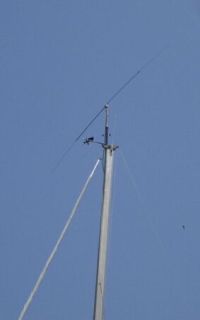
If you click on the picture, you'll get a bigger version.
We decided to mount a solid horizontal dipole above the top of the mast.
We choose to make the dipole from two 20M hamstick antennas. A mount was chosen that allowed horizontal orientation on a vertical mast. This mount required that the top of the mast be no larger than one and one quarter inches, so an old shovel handle was pressed into service.
The lightweight material we chose for the rest of the mast was one and one half inch PVC drain pipe. Its cheap, easy to work with; and if it fell, would not ding our host's sailboat. Since we had to put the mast in our vehicles, it was cut into six foot sections.
"BUT, hey wait a minute." I can hear some of you say. "That pipe isn't rigid." And, you're right, but it is rigid enough. Since none of us wanted to climb the sailboat's mast, we figured that the rotatable mast could be fastened to one of the halyards and hauled up into place at the top. During dry land testing, it was discovered that we needed wooden doweling at the joints to make the connections between sections rigid enough. Drilling a few holes and inserting wood screws created good connections. A sink drain adapter connected the shovel handle with the PVC pipe section. This mast was rigid enough to hold the dipole seven feet higher than its highest support point where the halyard pulled it tight to the sailboat mast.
The halyard on the sailboat's main mast was used to haul the antenna assembly into the air. This halyard was attached to the masting approximately seven feet below the dipole. By tilting the assembly out away from the sailboat mast as it was raised, the dipole cleared the sailboat rigging and the weather detection equipment. The full length mast was required in order to provide rotation capability and to stop the dipole from becoming a weather vane.